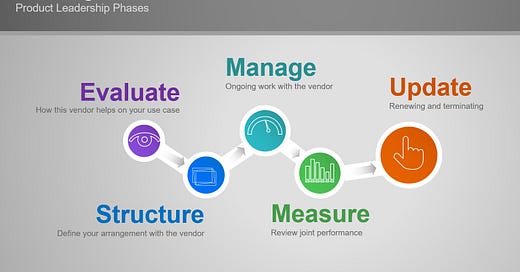Vendor Management is Leadership Part 2
Arrange a joint business partnership before locking your contract
Working with external vendors is a good way to scale your product. After evaluating a potential vendor, the next step is outlining the structure of working with them. Product managers are key in commercial arrangements with external vendors. At this phase, a product manager works with stakeholders and the external vendor to draft an arrangement that adds value.
Part 1 of this series discussed how to evaluate an external vendor. This article discusses the structure of an arrangement with an external vendor.
Defining the Vendor Arrangement
Once a vendor relationship is evaluated, you have an outline of a possible way of doing business with the vendor. You might find there are multiple ways to integrate and partner with the vendor. This is where your product management skills help you in choosing the lowest effort and highest value option to work with the vendor.
With this knowledge, you need to write down the potential arrangement with the vendor. This is written down in slides that can be shared with the vendor and with your product stakeholders. The desired outcome is an agreement in your organization and in the vendor's organization about:
Reasons to work together
Outline of the arrangement with joint customers
Resources needed to reach a joint agreement
Suggested next steps
This step to get joint buy-in to the potential arrangement is critical to reaching an agreement quickly. Your product management time can get eaten up fast if you don't have resources aligned in both organizations.
While outlining the possible arrangement with the vendor, you need to contact your legal team to discover what kind of contracts your organization has in place with this vendor. If there is an existing contract, then you might be able to use that contract or make minimal changes to it. If there is no prior contract with that vendor, then you will need to allocate more time to working with the vendor and onboarding that vendor.
Following up on the examples from Part 1 of this series, you have two potential vendors to outline:
Case B Engineering to Engineering: an existing contract with a Cloud provider
Case E Competitive Threat: a new contract with a vendor
The next two sections cover each case.
Vendor Arrangement - Existing Contract is Unchanged
For example, your lead architect has time to do a proof of concept trial of some new APIs from a Cloud provider. You agree the integration would be useful to a segment of your customers. You find there is a contract in place with the Cloud provider that states your product is licensed to use their APIs. You are unsure if the Cloud provider will do joint marketing with you. In a meeting with the Cloud provider, you discuss piloting the new APIs and joint marketing. In that meeting, you and the Cloud provider identify the resources needed for this arrangement and agree the existing contract covers the new APIs and joint marketing.
Your outline of the arrangement looks like this:
Reasons to work together: add joint customers by cross-promoting faster transactions
Joint customer arrangement: you add new customers and the Cloud provider gets more spending from your organization
Resources:
architects and engineers from both organizations
Technical whitepaper to tell customers how to use the new feature
Joint marketing plan
No further legal or procurement help needed
Next steps: periodic meeting with the Cloud provider on integration and pilot customers
The consequences of skipping the step of structuring the arrangement can be a big impact on your product management time. Some of the time savings are:
Your lead architect has corresponding architecture and engineering help from the Cloud provider
Technical marketing lead allocated to the whitepaper
Joint marketing program kicked-off
Engineering support for the early customers
Since the stakeholders in both organizations buy in to the arrangement, you got all of this support at one time.
Vendor Arrangement - New Contract Needed
Suppose you are a software product manager and your product team needs a vendor that can back up your data safely in the Cloud. You have evaluated the leading backup products and decided on a vendor that fits your requirements. You have worked with your legal team to establish a non-disclosure agreement and held initial meetings with this vendor. You and the vendor see value in working on a proof of concept together because joint customers want to use your products together.
Since you have no prior contracts with this vendor, you suggest a referral selling arrangement as a way to get early customer feedback. Your stakeholders prefer this arrangement since this is the first time to work with an outside vendor.
Your outline of the arrangement looks like this:
Reasons to work together: announce a partnership with the new vendor to generate sales leads
Joint customer arrangement:
Your organization refers customers to the backup vendor
The backup vendor sells their product to your customer and supports the customer
Your organization gets a referral fee
Resources:
Joint technical marketing to test a reference deployment of your product with the backup vendor
Consumption credits with the backup vendor for early customer trials
Technical whitepaper to tell customers how to use the backup product with your product
Joint marketing plan
Joint legal resources to create a reference selling contract
Next steps:
Preparation and approval of the reference sell contract
Joint testing of your product with the backup product by technical marketing resources
Early customers and joint marketing
Periodic meetings with the vendor on testing and early customers
You can use the approval of the reference sell contract as a way to generate interest and support for this initiative. Your success in this new vendor relationship depends on this cross-functional support!
Coming Soon: Part 3 of this series on vendor management discusses how to manage a contract with a vendor.




